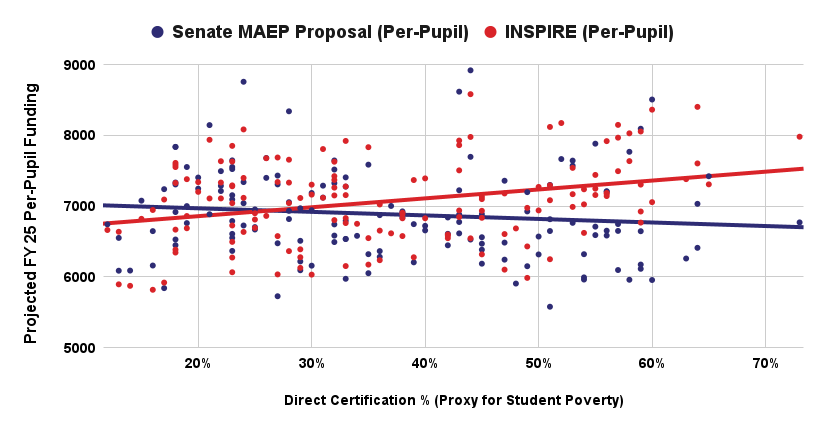This post is part of our ongoing analysis of 2024 education legislation. See our bill tracker here for all analyses.
In the 2024 legislative session, lawmakers have introduced two separate school funding proposals that each promise to inject at least an additional $200 million into funding for public education in Mississippi, with the House plan providing about $255M more while the Senate plan provides about $210M more. The Senate has proposed revising the existing MAEP school funding formula to reduce the cost necessary to “fully fund” the formula, thereby making it easier to fully fund (see our analysis of Senate Bill 2332 for more specifics). The House, meanwhile, has proposed replacing MAEP with the INSPIRE funding formula—the main feature of which is a series of additional funding “weights” for low-income students, English-language learners, and other high-need student groups (see our analysis of House Bill 1453 for more specifics).
At Mississippi First, we have a long-held fundamental belief about school funding: public schools should receive the resources necessary to provide an excellent education to every student they serve. In evaluating the two proposals, the question we ask is, “Which school funding formula is better for kids in Mississippi?” This question requires us to consider both adequacy and equity. “Adequacy” refers to the baseline level of resources that every district requires to effectively operate schools and provide students with an “adequate” education. This goal was so important to MAEP that it is part of the name–the Mississippi Adequate Education Program. “Equity” refers to the ability of a formula to allocate additional resources where there is greater student need. In recent years, MAEP has not provided equity, even though this was one of the founding principles of the formula.
Previously, we have written detailed analyses of what the INSPIRE plan as well as the Senate “tweaks” plan would do as part of our annual legislative tracker project. If you have not already read those analyses, you should take a short hop over to the INSPIRE post and to the Senate post before continuing, as we assume in the rest of this post that you understand the fundamental features.
In this blog, we will compare the effects of two proposals based on FY25 funding projections from the Legislative Budget Office (LBO) for each Mississippi school district and charter school. Specifically, we look at how projected per-pupil funding under each proposal compares to student poverty in each district to better understand which proposal provides more equitable funding.
Analysis
Again, the following analysis specifically seeks to determine which school funding proposal does a better job of directing resources to students in poverty. While the concept of “unique student needs” has many dimensions—disability status, language status, sparsity, etc.—the income status of families in a given district (and often the resulting tax base) is fundamentally entwined with that district’s ability to leverage resources to meet the needs of these families. Directing additional resources to districts with high rates of student poverty is therefore one of our highest priorities for any school funding formula.
We measure student poverty in each district using what’s known as “direct certification” or “identified student percentage”—essentially the percentage of students who are participating (or whose families are participating) in a means-tested federal antipoverty program, such as Head Start or the Supplemental Nutrition Assistance Program (SNAP) or who are categorically eligible due to situations such as homelessness or migrant status. We compare this measure of student poverty in each of Mississippi’s 148 school districts and charter schools to the projected per-pupil funding for FY25 under each school funding proposal, as determined by LBO. To understand more about why we are using this measure for poverty rather than free and reduced lunch, please see this explanation about why free and reduced lunch statistics no longer reliably measure poverty.
Figure 1 demonstrates the projected per-pupil funding for FY25 under the INSPIRE proposal (HB 1453, in orange) and the Senate proposal (SB 2332, in blue), compared to the direct certification percentage in each district. There is clearly substantial variation in projected per-pupil funding under each proposal—the result of everything from local property wealth (enabling some districts to generate more local funding) to student demographics not captured by the direct certification percentage (for instance, INSPIRE distributes additional funding for rural districts and districts with English-language learners). However, as the trendlines for each proposal demonstrate, districts with greater poverty (i.e., higher direct certification percentages) are generally projected to receive additional per-pupil funding under HB 1453—while the opposite appears to be the case under SB 2332.
Figure 1. Projected Per-Pupil Funding by Direct Certification Percentage

Using regression analysis—a statistical process for estimating the relationship between an independent and a dependent variable—we observe a statistically significant moderate, positive relationship between district poverty and projected per-pupil funding under the INSPIRE funding formula. (For those well-versed in statistical analysis, see Figure 2 for more details.) Specifically, for each percentage point increase in the percentage of students directly certified in each district, per-pupil funding increases by an average of $12.59. In other words, districts with higher rates of student poverty would, on average, receive more funding than districts with lower rates of poverty under the INSPIRE funding formula.
We observe a weak, negative relationship between district poverty and projected per-pupil funding under a revised Senate MAEP plan, though this relationship is not statistically significant. As district poverty increases, per-pupil funding under the Senate plan generally decreases somewhat, but the relationship is not strong enough to determine that this is not due to chance. In other words, districts with higher rates of student poverty would not, on average, receive more (or less) funding than districts with lower rates of poverty under the revised Senate MAEP plan.
Figure 2. Stata Output from Regression Analysis

In many ways, this result should not be surprising. The INSPIRE funding formula was intentionally designed to provide additional funding to high-need student groups. One of the funding “weights” under INSPIRE directs an additional 30% in per-pupil funding for each student who is directly certified—and another weight provides an additional 10% for each student who is directly certified above a “concentrated poverty” threshold of 35%. This regression analysis confirms that these weights would, in practice, achieve their stated objectives.
In contrast, MAEP only includes a single 5% “at-risk” weight, which—due to the indicator that MAEP uses to define “at-risk” (the flawed free-and-reduced lunch measure)—applies to a large majority of students in Mississippi. The result is that the revised MAEP does a poor job of differentiating the extent of student need between districts. This is unsurprising given the fact that MAEP is fundamentally flawed in how it allocates money, and the Senate plan does not address any of these actual problems, opting only to slow the growth of the formula’s cost. The problem with the very small at-risk component is exacerbated by other flaws in the decades-old formula, including, but not limited to:
- Failing to direct additional funding to districts with English-language learners (Mississippi is one of just two states nationwide that fails to do so);
- Penalizing districts with chronic absenteeism by counting students using Average Daily Attendance (ADA) rather than Average Daily Membership (ADM);
- Failing to require wealthier districts to contribute any funding for “add-on” programs (i.e., special education, gifted education, career and technical education, transportation, and alternative education); and
- Allocating funding for “add-on” programs based on the average salary of the relevant teachers in each district (resulting in additional funding for districts with more experienced and credentialed teachers as well as districts that can afford to pay more).
Conclusion: INSPIRE Is More Equitable
Given that each school funding proposal offers at least $200 million in additional funding over the current fiscal year, it is fair to say that both proposals would improve adequacy (i.e., the baseline level of resources for every district). But our analysis of projected per-pupil funding demonstrates that there is a substantive difference in how each proposal would allocate this funding. In other words, the primary distinction between INSPIRE and MAEP comes down to equity.
The INSPIRE formula is clearly far more equitable than MAEP. The statistical evidence is unambiguous: INSPIRE would provide additional funding to districts with higher rates of student poverty; under a revised MAEP, there is no relationship between funding and poverty. For anyone who shares our ultimate goal of ensuring that public schools receive the resources necessary to meet the unique needs of each student they serve, the choice is clear.

